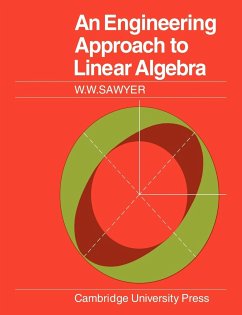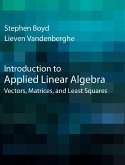- Broschiertes Buch
- Merkliste
- Auf die Merkliste
- Bewerten Bewerten
- Teilen
- Produkt teilen
- Produkterinnerung
- Produkterinnerung
The book is full of physical analogies and contains many worked and unworked examples, integrated with the text.
Andere Kunden interessierten sich auch für
![Introduction to Applied Linear Algebra Introduction to Applied Linear Algebra]() Stephen BoydIntroduction to Applied Linear Algebra61,99 €
Stephen BoydIntroduction to Applied Linear Algebra61,99 €![An Introduction to Homological Algebra An Introduction to Homological Algebra]() Charles A. WeibelAn Introduction to Homological Algebra52,99 €
Charles A. WeibelAn Introduction to Homological Algebra52,99 €![A Computational Introduction to Number Theory and Algebra A Computational Introduction to Number Theory and Algebra]() Victor ShoupA Computational Introduction to Number Theory and Algebra73,99 €
Victor ShoupA Computational Introduction to Number Theory and Algebra73,99 €![Introduction to Finite Fields and Their Applications Introduction to Finite Fields and Their Applications]() Rudolf LidlIntroduction to Finite Fields and Their Applications162,99 €
Rudolf LidlIntroduction to Finite Fields and Their Applications162,99 €![An Introduction to Rings and Modules An Introduction to Rings and Modules]() A. J. BerrickAn Introduction to Rings and Modules81,99 €
A. J. BerrickAn Introduction to Rings and Modules81,99 €![An Introduction to Field Theory An Introduction to Field Theory]() Iain T. AdamsonAn Introduction to Field Theory34,99 €
Iain T. AdamsonAn Introduction to Field Theory34,99 €![A Gateway to Abstract Mathematics A Gateway to Abstract Mathematics]() Edwin A. MaxwellA Gateway to Abstract Mathematics39,99 €
Edwin A. MaxwellA Gateway to Abstract Mathematics39,99 €-
-
-
The book is full of physical analogies and contains many worked and unworked examples, integrated with the text.
Hinweis: Dieser Artikel kann nur an eine deutsche Lieferadresse ausgeliefert werden.
Hinweis: Dieser Artikel kann nur an eine deutsche Lieferadresse ausgeliefert werden.
Produktdetails
- Produktdetails
- Verlag: Cambridge University Press
- Seitenzahl: 316
- Erscheinungstermin: 31. August 2008
- Englisch
- Abmessung: 246mm x 189mm x 17mm
- Gewicht: 614g
- ISBN-13: 9780521093330
- ISBN-10: 0521093333
- Artikelnr.: 25445373
- Herstellerkennzeichnung
- Libri GmbH
- Europaallee 1
- 36244 Bad Hersfeld
- gpsr@libri.de
- Verlag: Cambridge University Press
- Seitenzahl: 316
- Erscheinungstermin: 31. August 2008
- Englisch
- Abmessung: 246mm x 189mm x 17mm
- Gewicht: 614g
- ISBN-13: 9780521093330
- ISBN-10: 0521093333
- Artikelnr.: 25445373
- Herstellerkennzeichnung
- Libri GmbH
- Europaallee 1
- 36244 Bad Hersfeld
- gpsr@libri.de
Preface
1. Mathematics and engineers
2. Mappings
3. The nature of generalisation
4. Symbolic conditions for linearity
5. Graphical representation
6. Vectors in a plane
7. Bases
8. Calculations in a vector space
9. Change of axes
10. Specification of a linear mapping
11. Transformations
12. Choice of basis
13. Complex numbers
14. Calculations with complex numbers
15. Complex numbers and trigonometry
16. Trigonometry and exponentials
17. Complex numbers: terminology
19. The logic of complex numbers
20. The algebra of transformations
21. Subtraction of transformations' 22. Matrix notation
23. An application of matrix multiplication
24. An application of linearity
25. procedure for finding invariant lines, eigenvectors and eigenvalues
26. Determinant and inverse
27. Properties of determinants
28. Matrices other than square
partitions
29. Subscript and summation notation
30. Row and column vectors
31. Affine and Euclidean geometry
32. Scalar products
33. Transpose
quadratic forms
34. Maximum and minimum principles
35. Formal laws of matrix algebra
36. Orthogonal transformations
37. Finding the simplest expressions for quadratic forms
38. Principal axes and eigenvectors
39. Lines, planes and subspaces
vector product
40. Null space, column space, row space of a matrix
42. Illustrating the importance of orthogonal matrices
43. Linear programming
44. Linear programming, continued
Answers
Index.
1. Mathematics and engineers
2. Mappings
3. The nature of generalisation
4. Symbolic conditions for linearity
5. Graphical representation
6. Vectors in a plane
7. Bases
8. Calculations in a vector space
9. Change of axes
10. Specification of a linear mapping
11. Transformations
12. Choice of basis
13. Complex numbers
14. Calculations with complex numbers
15. Complex numbers and trigonometry
16. Trigonometry and exponentials
17. Complex numbers: terminology
19. The logic of complex numbers
20. The algebra of transformations
21. Subtraction of transformations' 22. Matrix notation
23. An application of matrix multiplication
24. An application of linearity
25. procedure for finding invariant lines, eigenvectors and eigenvalues
26. Determinant and inverse
27. Properties of determinants
28. Matrices other than square
partitions
29. Subscript and summation notation
30. Row and column vectors
31. Affine and Euclidean geometry
32. Scalar products
33. Transpose
quadratic forms
34. Maximum and minimum principles
35. Formal laws of matrix algebra
36. Orthogonal transformations
37. Finding the simplest expressions for quadratic forms
38. Principal axes and eigenvectors
39. Lines, planes and subspaces
vector product
40. Null space, column space, row space of a matrix
42. Illustrating the importance of orthogonal matrices
43. Linear programming
44. Linear programming, continued
Answers
Index.
Preface
1. Mathematics and engineers
2. Mappings
3. The nature of generalisation
4. Symbolic conditions for linearity
5. Graphical representation
6. Vectors in a plane
7. Bases
8. Calculations in a vector space
9. Change of axes
10. Specification of a linear mapping
11. Transformations
12. Choice of basis
13. Complex numbers
14. Calculations with complex numbers
15. Complex numbers and trigonometry
16. Trigonometry and exponentials
17. Complex numbers: terminology
19. The logic of complex numbers
20. The algebra of transformations
21. Subtraction of transformations' 22. Matrix notation
23. An application of matrix multiplication
24. An application of linearity
25. procedure for finding invariant lines, eigenvectors and eigenvalues
26. Determinant and inverse
27. Properties of determinants
28. Matrices other than square
partitions
29. Subscript and summation notation
30. Row and column vectors
31. Affine and Euclidean geometry
32. Scalar products
33. Transpose
quadratic forms
34. Maximum and minimum principles
35. Formal laws of matrix algebra
36. Orthogonal transformations
37. Finding the simplest expressions for quadratic forms
38. Principal axes and eigenvectors
39. Lines, planes and subspaces
vector product
40. Null space, column space, row space of a matrix
42. Illustrating the importance of orthogonal matrices
43. Linear programming
44. Linear programming, continued
Answers
Index.
1. Mathematics and engineers
2. Mappings
3. The nature of generalisation
4. Symbolic conditions for linearity
5. Graphical representation
6. Vectors in a plane
7. Bases
8. Calculations in a vector space
9. Change of axes
10. Specification of a linear mapping
11. Transformations
12. Choice of basis
13. Complex numbers
14. Calculations with complex numbers
15. Complex numbers and trigonometry
16. Trigonometry and exponentials
17. Complex numbers: terminology
19. The logic of complex numbers
20. The algebra of transformations
21. Subtraction of transformations' 22. Matrix notation
23. An application of matrix multiplication
24. An application of linearity
25. procedure for finding invariant lines, eigenvectors and eigenvalues
26. Determinant and inverse
27. Properties of determinants
28. Matrices other than square
partitions
29. Subscript and summation notation
30. Row and column vectors
31. Affine and Euclidean geometry
32. Scalar products
33. Transpose
quadratic forms
34. Maximum and minimum principles
35. Formal laws of matrix algebra
36. Orthogonal transformations
37. Finding the simplest expressions for quadratic forms
38. Principal axes and eigenvectors
39. Lines, planes and subspaces
vector product
40. Null space, column space, row space of a matrix
42. Illustrating the importance of orthogonal matrices
43. Linear programming
44. Linear programming, continued
Answers
Index.








